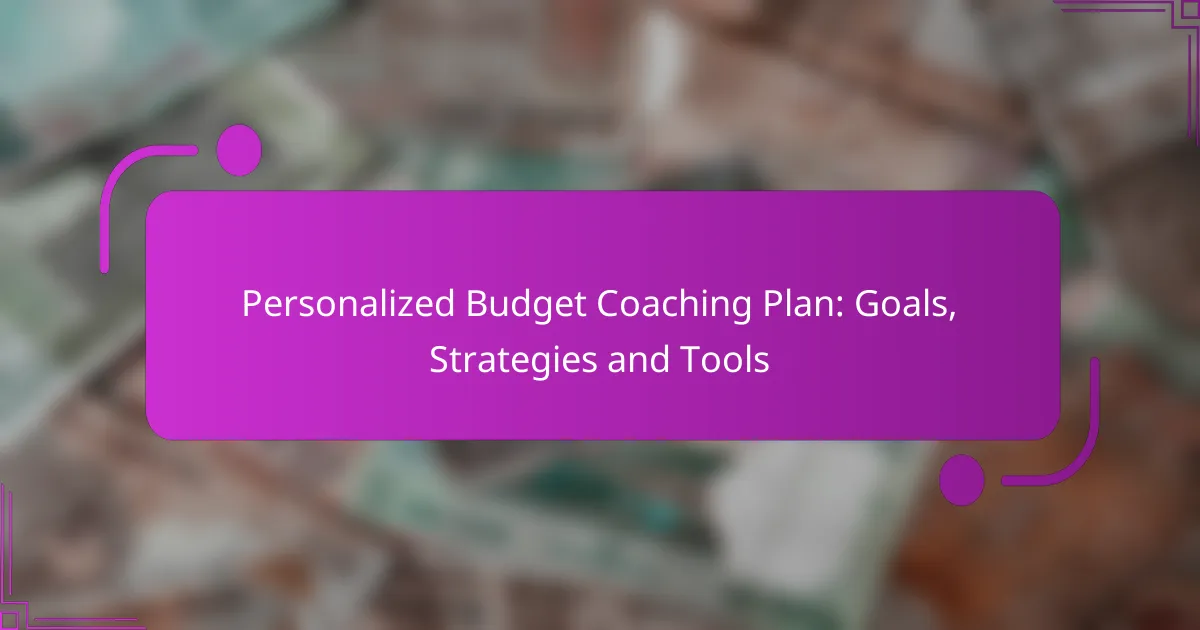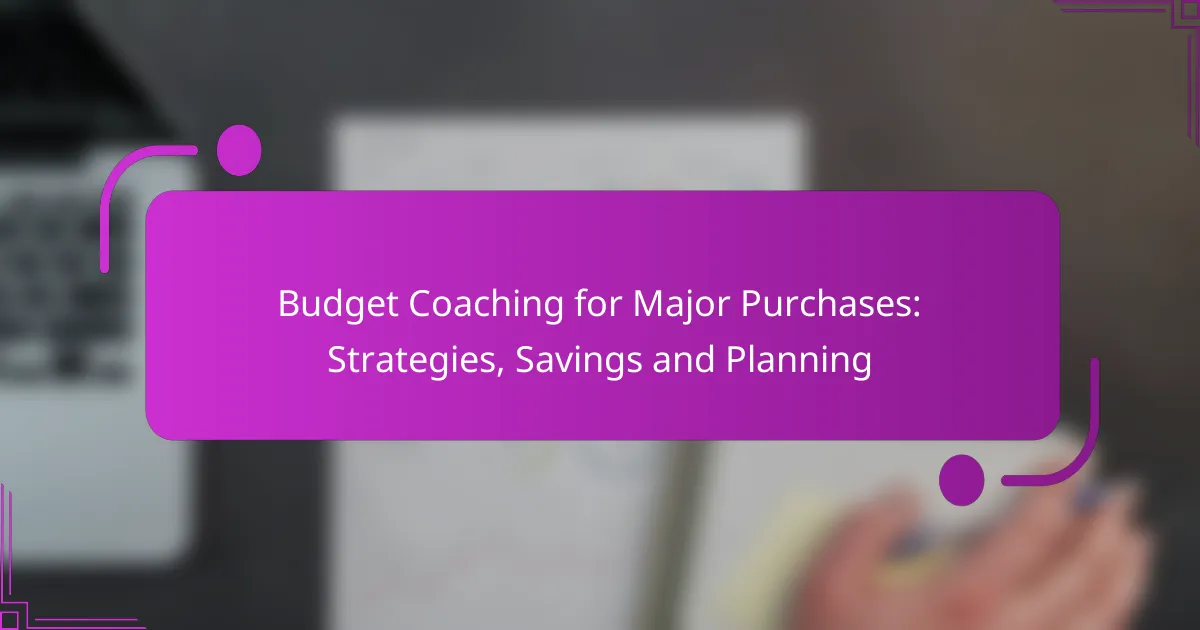Budget coaching apps are essential tools for individuals seeking to manage their finances with greater efficiency. These apps offer features such as expense tracking, budget creation, and personalized financial advice, catering to various budgeting needs. By focusing on usability and insightful reporting, they enhance user experiences and make the budgeting process more engaging and less intimidating.
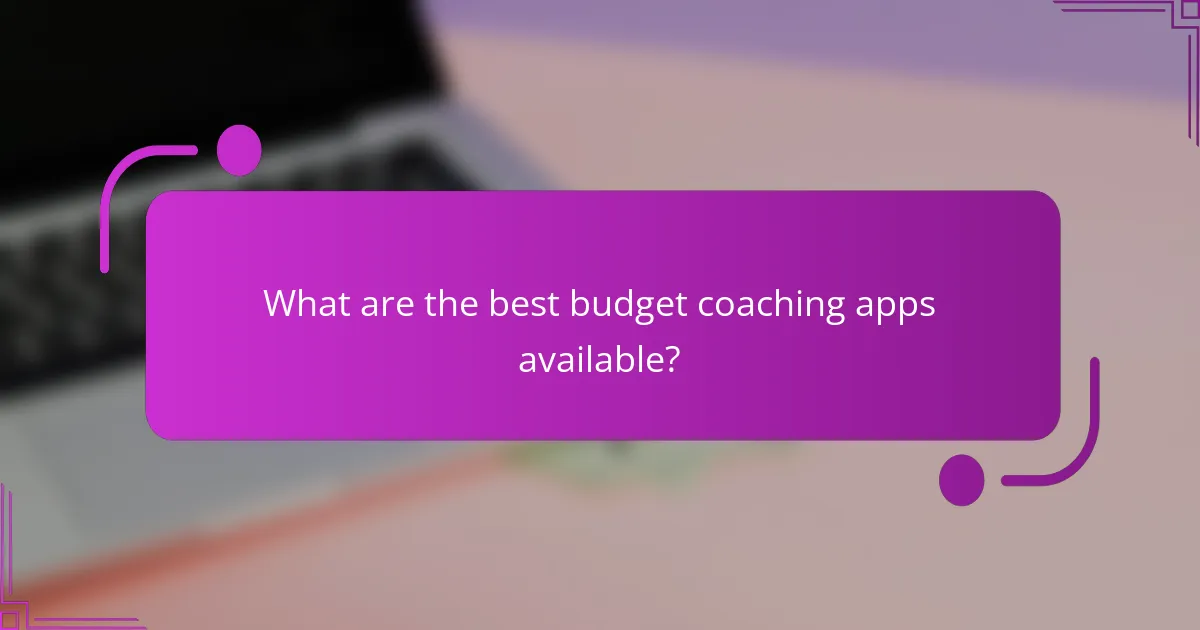
What are the best budget coaching apps available?
The best budget coaching apps help users manage their finances effectively by providing tools for tracking expenses, creating budgets, and offering personalized financial advice. Popular options include Mint, YNAB, EveryDollar, GoodBudget, and PocketGuard, each with unique features tailored to different budgeting needs.
Mint
Mint is a widely used budgeting app that offers a comprehensive view of your financial health by aggregating all your accounts in one place. Users can track spending, set budgets, and receive alerts for bill payments, making it easier to stay on top of finances.
One of Mint’s key features is its ability to categorize transactions automatically, which helps users identify spending patterns. However, some users may find the ads and promotional offers distracting.
YNAB (You Need A Budget)
YNAB focuses on proactive budgeting, encouraging users to allocate every dollar they earn to specific expenses or savings goals. This approach helps users prioritize their spending and build a more intentional financial plan.
YNAB offers educational resources and workshops to help users understand budgeting principles. While it requires a subscription fee, many users find that the investment pays off through improved financial management.
EveryDollar
EveryDollar is a straightforward budgeting app designed for users who prefer a zero-based budgeting method. Users create a budget by assigning every dollar of income to specific categories, ensuring that all expenses are accounted for.
The app offers a free version with basic features, while the paid version includes bank syncing for automatic transaction tracking. This simplicity makes it an excellent choice for beginners.
GoodBudget
GoodBudget uses the envelope budgeting system, allowing users to allocate funds to different categories as if they were using physical envelopes. This method helps users visualize their spending limits and manage cash flow effectively.
The app is available on multiple devices, making it easy to access your budget on the go. However, it does not sync with bank accounts, requiring manual entry of transactions, which may be a drawback for some users.
PocketGuard
PocketGuard simplifies budgeting by showing users how much disposable income they have after accounting for bills, goals, and necessities. This feature helps users avoid overspending and stay within their financial limits.
The app also provides insights into recurring expenses and offers suggestions for reducing costs. While it has a free version, the premium subscription unlocks additional features like custom categories and advanced reporting tools.

What features should I look for in a budget coaching app?
When selecting a budget coaching app, prioritize features that enhance usability, track expenses effectively, facilitate goal setting, and provide insightful reporting. These elements will help you manage your finances more efficiently and achieve your financial objectives.
User-friendly interface
A user-friendly interface is crucial for a budget coaching app, as it ensures that users can navigate the app easily without feeling overwhelmed. Look for apps with intuitive layouts, clear icons, and straightforward navigation menus.
Consider apps that offer customization options, allowing you to tailor the interface to your preferences. This can enhance your experience and make budgeting feel less like a chore.
Expense tracking
Effective expense tracking is a key feature of budget coaching apps, enabling users to monitor their spending habits in real-time. Choose an app that allows you to categorize expenses, making it easier to identify areas where you can cut back.
Some apps offer automatic syncing with bank accounts, which can save time and reduce manual entry errors. Look for options that provide alerts for overspending in specific categories to help you stay on track.
Goal setting
Goal setting features help users define and pursue their financial objectives, whether it’s saving for a vacation or paying off debt. An effective app should allow you to set specific, measurable goals and track your progress over time.
Consider apps that offer reminders and motivational prompts to keep you engaged with your goals. This can significantly enhance your commitment to achieving your financial targets.
Reporting and analytics
Reporting and analytics features provide valuable insights into your financial behavior, helping you make informed decisions. Look for apps that generate visual reports, such as charts and graphs, to illustrate your spending patterns and budget adherence.
Some apps may offer comparative analytics, allowing you to benchmark your spending against similar users. This can provide context and motivate you to improve your financial habits.

How do budget coaching apps enhance user experiences?
Budget coaching apps enhance user experiences by providing tailored financial guidance, real-time insights, and community engagement. These features help users manage their finances more effectively, making budgeting less daunting and more interactive.
Personalized budgeting plans
Personalized budgeting plans are a core feature of budget coaching apps, allowing users to create financial strategies that align with their individual goals and spending habits. By analyzing income, expenses, and financial objectives, these apps can suggest customized budgets that adapt over time.
For instance, if a user aims to save for a vacation, the app can recommend specific savings targets and allocate funds accordingly. This tailored approach increases the likelihood of achieving financial goals and helps users stay motivated.
Real-time notifications
Real-time notifications keep users informed about their spending habits and budget status, enhancing accountability. These alerts can notify users when they approach budget limits, when bills are due, or when they receive income, helping them stay on track.
For example, a user might receive a notification if they are nearing their monthly dining out budget, prompting them to reconsider their spending. This immediate feedback can prevent overspending and encourage better financial decisions.
Community support features
Community support features foster a sense of belonging and motivation among users. Many budget coaching apps include forums or social platforms where users can share experiences, tips, and encouragement, creating a supportive environment for financial growth.
Engaging with a community can provide users with valuable insights and diverse strategies for budgeting. Users can also participate in challenges or group goals, which can enhance commitment and make the budgeting process more enjoyable.
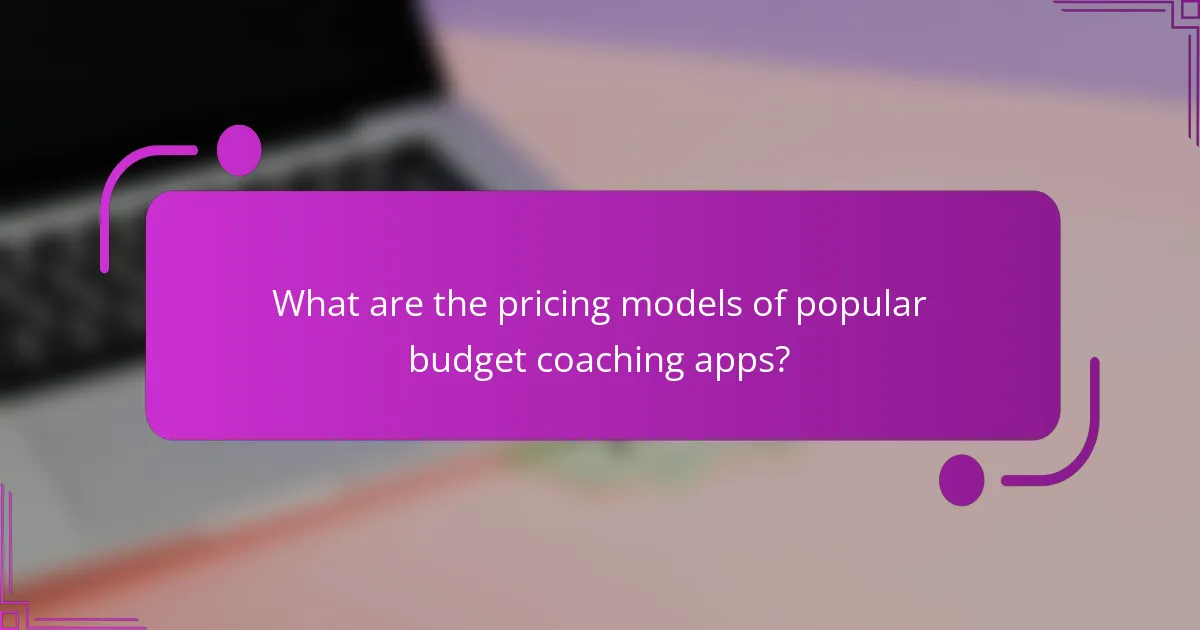
What are the pricing models of popular budget coaching apps?
Popular budget coaching apps typically offer a range of pricing models to accommodate different user needs. These models include free versions, subscription-based pricing, and one-time purchase options, each with its own set of features and limitations.
Free versions
Many budget coaching apps provide free versions that allow users to access basic features without any cost. These free versions often include essential budgeting tools, expense tracking, and limited financial advice.
However, users may encounter restrictions such as ads, limited access to premium features, or a cap on the number of transactions they can track. It’s advisable to assess whether the free version meets your budgeting needs before considering an upgrade.
Subscription-based pricing
Subscription-based pricing is a common model for budget coaching apps, typically charging users monthly or annually. Prices can range from around $5 to $15 per month, depending on the features offered, such as personalized coaching, advanced analytics, or integration with bank accounts.
This model often provides users with a more comprehensive budgeting experience, including ongoing support and updates. Be sure to evaluate the value of the features included in the subscription to ensure it aligns with your financial goals.
One-time purchase options
Some budget coaching apps offer a one-time purchase option, allowing users to pay a single fee for lifetime access to the app’s features. Prices for these apps can vary widely, often ranging from $20 to $100.
This model can be appealing for users who prefer not to commit to ongoing payments. However, it’s important to check if future updates or additional features are included or if they require separate purchases, as this can affect long-term value.
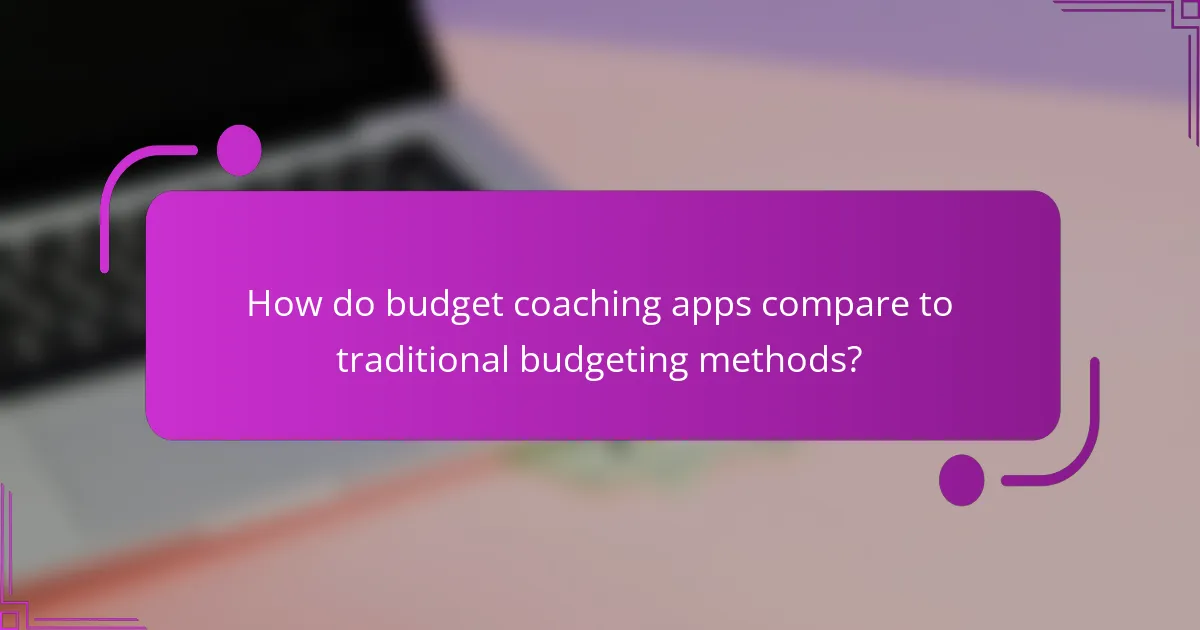
How do budget coaching apps compare to traditional budgeting methods?
Budget coaching apps offer a more interactive and personalized approach to managing finances compared to traditional budgeting methods. While traditional methods often rely on spreadsheets or pen-and-paper tracking, these apps provide real-time insights, automated tracking, and tailored advice to help users stay on budget.
Features of Budget Coaching Apps
Budget coaching apps typically include features such as expense tracking, goal setting, and personalized coaching. Users can link their bank accounts for automatic transaction imports, categorize spending, and receive alerts when approaching budget limits. Many apps also offer educational resources to improve financial literacy.
Some popular apps may include gamification elements, rewarding users for achieving financial milestones. This can enhance user engagement and motivation, making budgeting feel less like a chore.
User Experiences with Budget Coaching Apps
Users often report that budget coaching apps simplify the budgeting process, making it more accessible and less intimidating. The visual representations of spending patterns and progress towards goals can provide clarity and encourage better financial habits.
However, some users may find the learning curve steep, especially if they are not tech-savvy. It’s essential to choose an app that aligns with one’s comfort level and financial goals to ensure a positive experience.
Comparisons to Traditional Budgeting Methods
Traditional budgeting methods, such as using spreadsheets or manual tracking, can be effective but often lack the automation and real-time feedback that apps provide. While some individuals prefer the tactile nature of pen-and-paper budgeting, others may appreciate the efficiency of digital tools.
In terms of cost, many budget coaching apps offer free versions with basic features, while more comprehensive services may charge a monthly fee. Traditional methods, on the other hand, incur no direct costs but may require more time and effort to maintain.

